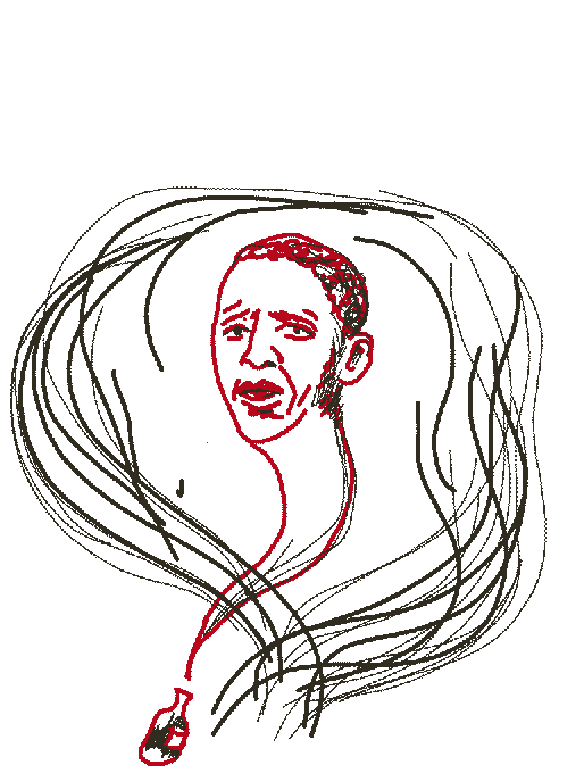First lady Melania Trump on Saturday closed out her first ever solo international trip to Africa in a face-to-face with Egypt’s Great Sphinx of Giza, one of the most mysterious statues in the world, which was built in homage to a mythical creature with the head of a king and the body of a lion.
It was a fitting end to the weeklong journey to Ghana, Malawi, Kenya and Egypt for Trump, who thus far into her tenure has proven to be one of the most private and guarded first ladies in modern history, and whose own secretive nature has given rise to myriad theories about her personality, her role and her marriage.
The visit to Africa did little to quell the ongoing who-is-she, who-is-she-not debate, but it did provide an opportunity for Trump’s debut impromptu press conference in Egypt with the small group of seven reporters who crisscrossed the continent with her throughout the trip.
With the Sphinx at her back, Trump, who like her husband is notoriously wary of the media, walked towards the press and revealed her thoughts about the #MeToo movement, now-Supreme Court Justice Brett Kavanaugh, her husband’s poor Twitter manners, his comments about African countries and her personal fashion habits.
On the Supreme Court’s latest justice
On Kavanaugh, whose protracted nomination process back home usurped most of the media coverage of her maiden solo trip, Trump sided with her husband, saying to reporters that she felt good about the choice.
“If we’re talking about the Supreme Court and Judge Kavanaugh, I think he’s highly qualified for the Supreme Court,” she said. But she added, “I’m glad that Dr. Ford was heard. I’m glad that judge Kavanaugh was heard. The FBI investigation was done, is completed and Senate voted.”
And if she, the first lady of the United States, flat-out believed the story of the alleged sexual abuse Christine Blasey Ford suffered 36 yeas ago, Trump refrained from committing to a simple yes or no, opting instead to throw her support behind anyone who has ever faced a predator.
“We need to help all the victims no matter what kind of abuse they had, but I am against any kind of abuse or violence,” she said.
On the President’s Twitter thumbs
Though expectedly more aligned with her husband than the resistance, she shed a little daylight on the relationship she has with her husband, noting assuredly that she has her own ideologies, and when they don’t always align with the President, opposition happens.
“I don’t always agree [with] what he tweets, and I tell him that. I give him my honest opinion and honest advice, and sometimes he listens and sometimes he doesn’t, but I have my own voice and my opinions,” said Trump. “It’s very important for me that I express what I feel. … He’s the President, but I give him my opinions.” Pausing for a beat after she was asked if she has ever told her husband to put his phone down, Trump laughed and said ,”yes.”
Melania Trump’s happiness level away from Washington
With President Trump – and his tweets – far out of range, as has been the case on previous long trips abroad, Trump again seemed happier and more at ease on the global stage, at times even ebullient and carefree. When she bottle-fed a herd of baby orphaned elephants at the David Sheldrick Wildlife Trust in Nairobi, Kenya, the first lady – at first hesitant to get too close to the pachyderms, was soon right up next to them, petting them, tickling their ears, and laughing a deeper, throatier laugh, a new sound from a woman whose restrained emotions rarely peak above a giggle. When one of the elephants made a bit of a run towards her, she stumbled back a few steps at first, then smiled, stepping right up to her original spot.
And who wouldn’t be happy playing with a pack of adorable baby elephants?
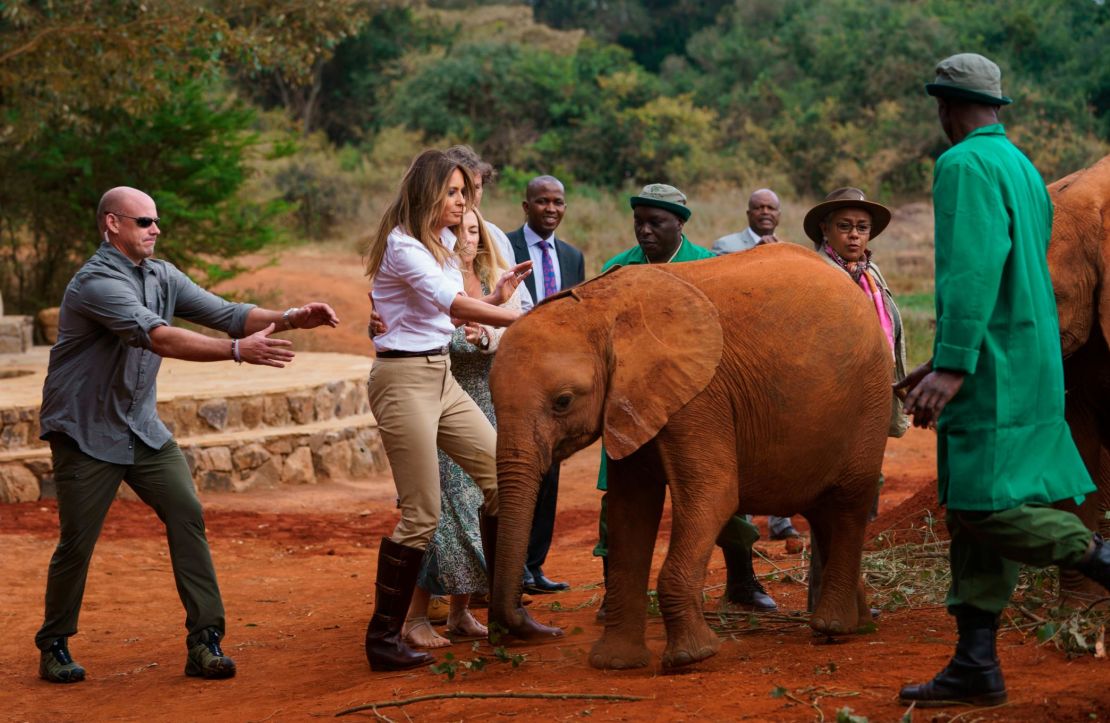
It seemed to be as an authentic a “Melania moment” as most Americans have witnessed since her tenure as first lady began almost two years ago.
“Reporters who covered Hillary Clinton when she was first lady told me she became more and more open and likable the farther she was from Washington, and I think the same is true of this first lady,” says historian and author Kate Andersen Brower, who wrote “First Women: The Grace and Power of America’s Modern First Ladies.” “But she is so much more guarded than Hillary Clinton – which is hard to believe – and so I think, for [Mrs. Trump], this was as transparent and open as we may ever see her.”
Melania heads to school
And while the smiles and relaxation were evident throughout the week and in other countries, there were also handful of times when her face was pensive and reflective about what she was witnessing on this, her very first trip to a continent whose people are beloved and admired for having deep joy and resilience in the face of issues like widespread poverty, disease and technological isolation, as is seen in some African countries.
In Malawi, the third poorest country in the world, according a 2018 International Monetary Fund report, and Trump’s second stop on the trip after Ghana, Trump chose to visit the Chipala Primary School. The school presented an example of the state of education in the country. Only 77 teachers educate a staggering 8,544 students, all crammed into 22 dank and dark indoor classrooms as well as improvised outdoor ones, with hundreds sitting on the red dirt in their dust-covered uniforms, some blue (the more expensive), others brown (the more affordable option), straining necks to get a glimpse at the chalkboard and lessons in English words.
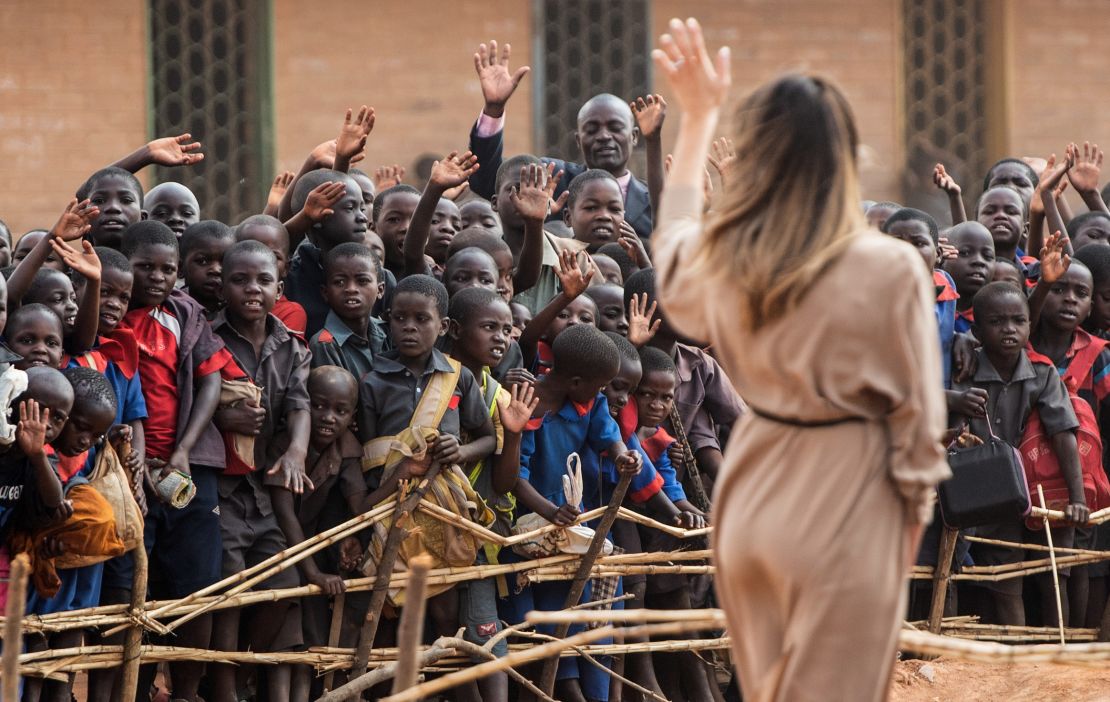
At Chipala, Trump moved from classroom to classroom, sitting in with second- and third-graders, most with cardboard signs strung with twine around their necks stating their names in large lettering. She looked on as the children had their lessons, asking questions of the headmistress, and in one room, sitting with a little boy in the front of the room, leaning into him to share his book and study along. Trump seemed measured and engaged, yet at times during her school visit, her perma-grin would dissolve, taking in the striking disparity between this reality of Malawi and almost every other country and every other school she has visited thus far as first lady.
From the school’s perimeter, one could see the faces of the children who weren’t able to be inside, in their tattered T-shirts and bare feet, wistfully looking at their peers in class, the ones who were getting an education that could very well change the path of their country’s future.
In the school library, seated at a table with the head teacher and administrators, words on the chalkboard behind her reading, “First Lady Melania Trump Welcome,” the first lady made brief remarks about USAID’s national reading program, which was donating on Trump’s behalf another 1.4 million textbooks to the more than 5,600 primary schools in Malawi, bringing the total to 9.6 million the total number of books for Malawian children in grades one through four that USAID has provided.
“I wanted to be here to see the successful programs that (the) United States is providing the children and thank you for everything you’ve done,” said Trump.
She also brought Be Best tote bags for the teachers, packed with much-needed school supplies.
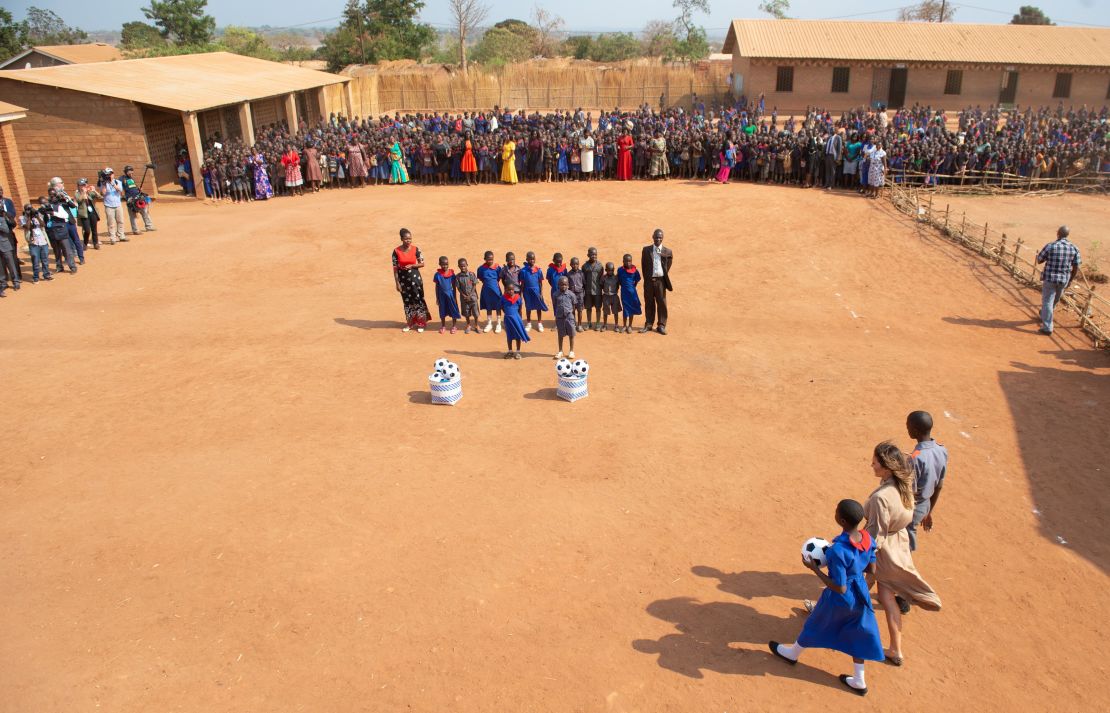
Later, students and teachers formed a giant ring around a dirt playground, singing and laughing, awaiting Trump, who eventually walked towards them to a preset spot in the middle of the “field” to hand out several soccer balls, emblazoned with the Be Best logo, another donation to the school. Despite the rare flat footwear she wore for the occasion, the first lady didn’t join in on the impromptu game, instead standing off to the side in her khaki silk dress, watching and smiling as boys and girls kicked around their new, bright white soccer balls. Towards the end of her visit to Chipala, the children once again happily danced and chimed in on a native song.
“I know one day we shall meet again,” they sang as Trump climbed into her motorcade and rolled out.
It was a different scene in Ghana, though no less moving, where Trump during one day visited babies in a local hospital and on another arrived to the country’s Cape Coast region, participating in a welcome ceremony inside an auditorium named Obama Hall, in honor of then-President Barack Obama and first lady Michelle Obama’s 2009 visit. But it was Trump’s tour of Cape Coast Castle, one of 40 or so remaining slave trade outposts in the region, that appeared to move Trump, who afterward told the press that learning the castle’s history and hearing slavery stories from her guide was “very emotional.” She lay a wreath at the “Door of No Return,” where slaves who had been bought by trans-Atlantic merchants were led through and down to the shoreline to board the ships that would take them to another country far away from home, to another life, unlike anything they had known.
“What happened so many years ago was really a tragedy,” she said.
However, by the time she was in Kenya, Trump was back in the groove, literally.
When she arrived at The Nest, a children’s orphanage in Nairobi, a line of about two dozen kids in vibrant yellow shirts grabbed her hands and led the first lady down a paved path to the nursery, singing and dancing. And she moved too – a bit. Swaying her hips from side to side, Trump performed a mild shimmy, sort of a walk-dance hybrid, but still the first time she had publicly danced since taking a spin with President Trump at Inaugural Balls.
Why Africa?
The mere fact that Trump chose Africa for her inaugural solo international trip, when her husband’s reported derogatory remarks about certain countries here set off a firestorm of controversy earlier this year, demonstrates at least a certain amount of desire on her part to put a face to an administration whose leader is not seen as particularly benevolent. Trump said she wasn’t affected by the alleged s-hole countries comments, because no one brought them up to during visits with local dignitaries, and also because she didn’t believe they were said in the first place.
“Nobody discussed that with me, and I never heard him say any of those comments, and that was ‘anonymous source’ and I would leave it at that,” she told the press during her Saturday news conference.

“[Mrs. Trump] has the opportunity to be a great global diplomat, which first ladies are inherently by their position,” says Anita McBride, former chief of staff for Laura Bush. “Her role should be to represent the president and the American people, especially with these particular countries.”
McBride says that nodding to the cultural components of the places she visits is important, but it’s a fine-line between actually having a purpose on behalf of Americans and just sweeping through a continent on an extended photo op.
“If she has success projecting a message of working with USAID, to see programs in Africa and learn about them, and share what she knows with the host countries, it’s a win,” McBride said. “[President George W.] Bush viewed Africa and its potential, and thought about what we could do to help eradicate a disease that was killing them,” referring to the HIV/AIDS epidemic and the President’s Emergency Plan For AIDS Relief, a Bush administration program that has dramatically lowered the infection rate in Africa. President Trump has cut funding for AIDS assistance programs like PEPFAR.
“Mrs. Bush worked to promote the president’s plan with PEPFAR, visiting Africa on seven separate times as first lady,” says McBride.
Trump went to Africa not only without a succinct game plan for how to communicate her platform, but also completely out of sync with her husband’s administration’s policies there. Trump in a September speech had advertised her maiden solo trip as a chance to spread the word about Be Best, her broad children’s wellness initiative, which spans topics from the opioid crisis to social media bullying to physical health.
“I am so proud of the work this administration is doing through USAID and others,” said Trump, “and look forward to the opportunity to take the message of my Be Best campaign to many of the countries, and children, throughout Africa. Whether it is education, drug addiction, hunger, online safety or bullying, poverty or disease, it is too often children who are hit first, and hardest, across the globe.”
And although she did partner on the trip with USAID, which donates millions of dollars on behalf of America to help organizations throughout Africa, she couldn’t avoid questions about the decline in funding the program has faced in the wake of her husband’s budget cuts. Asked by a reporter towards the end of her trip in Egypt if she planned to ask President Trump to restore more cash flow to USAID now that she had visited Africa, Trump pushed back on the need.
“We are having funding, so we are helping the countries, and we’re working hard helping them and we will continue to do so,” she said.
Yet it was her own program, Be Best, that seemed at times to get lost in the shuffle of schools and hospitals, orphanages and cultural tours. While branded tote bags and blankets and stuffed animals and frisbees where often in the periphery of each stop along her way, the red and blue logo displayed on each, actual discussion of the need and purpose of her nascent platform was few. Given an opportunity to say what she thought her biggest accomplishment on the trip had been, Trump said: “Meeting with the people, and thanking me for that I came, and they were all very warm and welcoming.”
When a reporter asked the first lady what the message she wanted to send from her husband’s administration to Africa was, Trump said, “That we care and we want to show the world that we care.”
It was a word choice, intended or no, that bluntly contrasted the words on the back of a $40 jacket she wore in June while getting on and off of her plane at Andrews Air Force Base in Maryland on a day trip to the US-Mexico border to witness firsthand, her spokeswoman said at the time, the immigration crisis crippling families crossing into America. In bold white letters, the jacket read “I really don’t care, do u?” which quickly became the meme of all memes, and a stark visual that critics could point to as tangible proof of an administration widely believed to be okay with tearing children from their parents at our borders. More disastrously, the jacket has been the biggest hurdle for Trump herself in terms of public perception, lending to the idea many Americans have of the first lady that she is detached and aloof.
A visually stunning trip not without controversy
Yet in terms of gaffes and missteps, Trump had just a couple on this trip, but they were significant enough to warrant headlines.
To some, they were simply more examples of a first lady forging an independent path, a woman with little concern for the ties that bind her to her family, and the way East Wing objectives have in the past typically aligned with those of the West Wing.
In addition to the elephant orphanage in Kenya, Trump also went on safari, which on the surface would seem the most innocuous and expected activity of a trip to the country – which it very much was – but which also stirred up two controversies for two very different reasons.
As soon as images of Trump with the baby elephants hit the internet and airwaves, there were cries of hypocrisy. How could she support animal conservation efforts when her own stepsons, Eric Trump and Donald Trump Jr, are avid big game hunters, and vocal about it?
Trump Jr., once posed for a photo on a hunting trip to Zimbabwe, holding an elephant’s tail that he had sliced off after his kill.
Another image showcases the brothers holding a big cat, dead in Eric’s arms, with the brothers smiling.
Though perhaps unfair to stick Trump with the responsibility for the private activities of her grown stepsons, it is by no means out of bounds to seek an answer about where she herself stands on the issue in light of their sporting habits, (and if hers is one of those opposing “opinions” she has on her own that doesn’t jibe with her husband’s.)
After all, in March, President Trump loosened the rules for trophy hunting imports to the United States.
“Mrs. Trump thinks animals are precious and she does not like big game hunting,” Stephanie Grisham, Trump’s spokeswoman, told CNN when asked how the first lady’s support of conservation efforts in Kenya clashed with her family’s hobbies.
In Kenya, on her safari in Nairobi National Park this week, the first lady, in an open-topped Land Cruiser, binoculars in hand, viewed herds of zebras, impalas, and a few giraffes and hippopotamuses, occasionally snapping pictures on her personal cellphone.
She looked like she had taken wardrobe cues for the day from Meryl Streep’s character, Karen Blixen, in the 1985 film, “Out of Africa,” in her white button-down shirt, khaki jodhpurs and tall, brown riding boots. But it was her hat that made headlines, in all the wrong ways. Trump opted for a white pith helmet, which, while it matched sartorially, proved appallingly offensive to many Africans. The helmets are associated with the clothing worn by white colonists in the early 1900s.
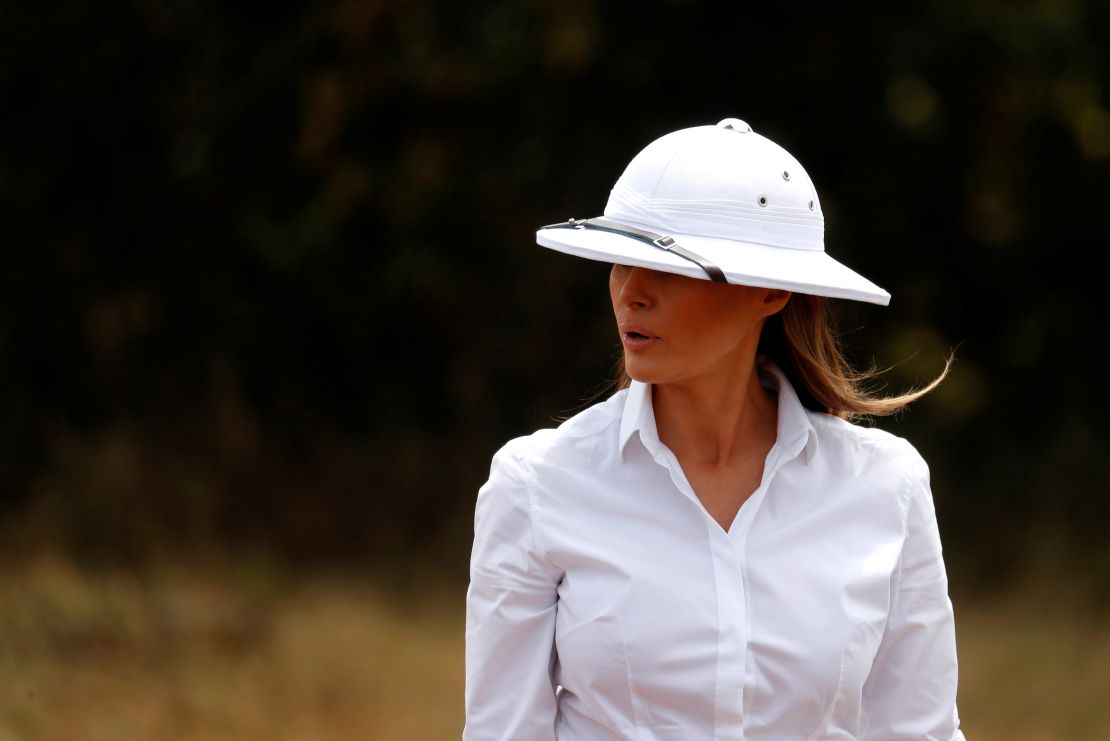
Matt Carotenuto, a historian and coordinator of African Studies at St. Lawrence University, compared the hat choice to “(showing) up on an Alabama cotton farm in a confederate uniform,” saying that Trump on Friday “(completed) the stereotype trifecta – elephants, orphans and even the pith helmet.”
“You know what? We just completed an amazing trip. We went to Ghana. We went to Malawi. We went to Kenya. Now here we are in Egypt. I want to talk about my trip and not what I wear,” an indignant Trump told CNN when asked how she felt about the criticism her safari hat was culturally insensitive to the people of the continent she was visiting.
However, as she pushed back on all the focus on her garments, she was doing so while touring the Great Pyramids dressed head to toe in a show-stopping cream ensemble, with black necktie, wide-legged slacks and a Ralph Lauren jacket, draped as she often likes to do, over her shoulders, no sleeves through the arm holes. Not scared off by the prior day’s controversy, she also opted for another white hat, this time a Panama-style straw number from the French fashion house of Chanel.
Some said the outfit made her look like Diane Keaton in “Annie Hall.” Others went with the villain from “Indiana Jones Raiders of the Lost Ark,” or even Michael Jackson in the music video for the song “Smooth Criminal.” A former model with arguably one of the choicest wardrobes in modern first lady history, Trump has to be well aware that what she wears is prone to double-takes, from admirers and detractors alike.
“I wish people would focus on what I do, not what I wear,” Trump said in her designer clothes, which could have been plucked from a stylist’s racks on a Vogue magazine photo shoot. A magazine, by the way, that has yet to put her in its pages when it has previously done so for every other first lady of the past two decades.
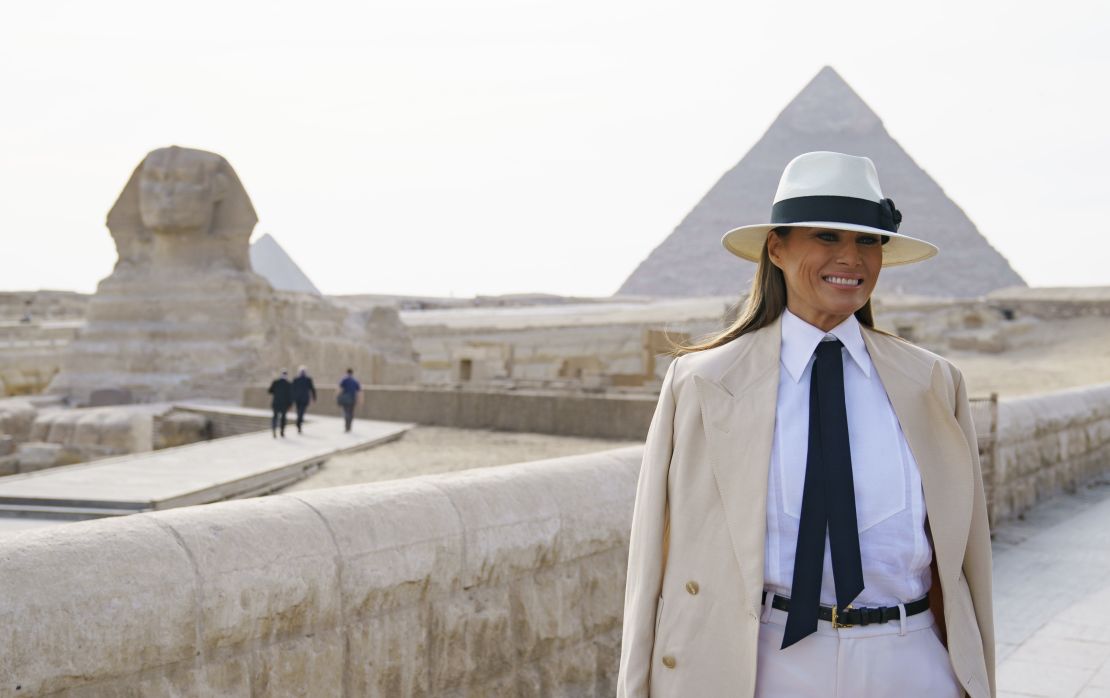
Moments after making that statement, Trump walked like a runway model back and forth across the panoramic vistas of the Great Pyramids as photographers clicked away. Dramatic instrumental music played loudly from the speakers of a dance troupe no one was watching – because all eyes were on Melania Trump alone.
Asked if a second solo sojourn was in the works, she smiled and replied, “First we need to come home, and then we’ll plan, maybe, another one.”




















